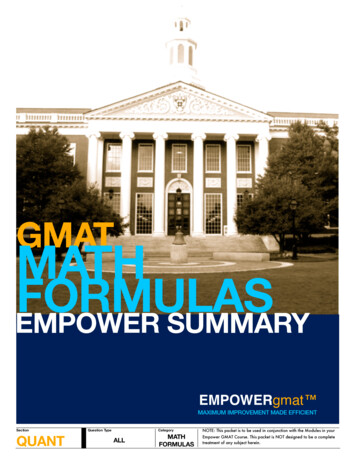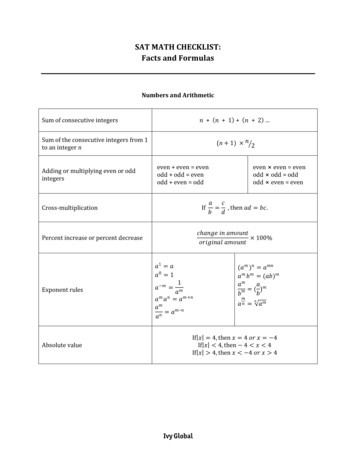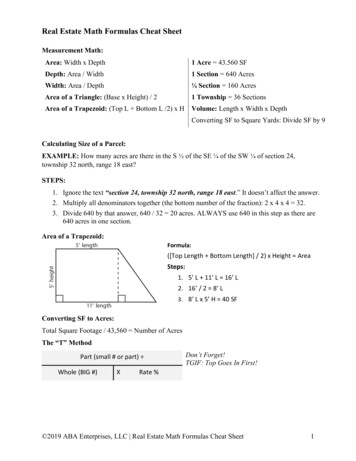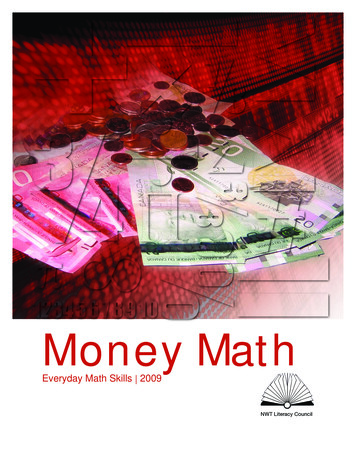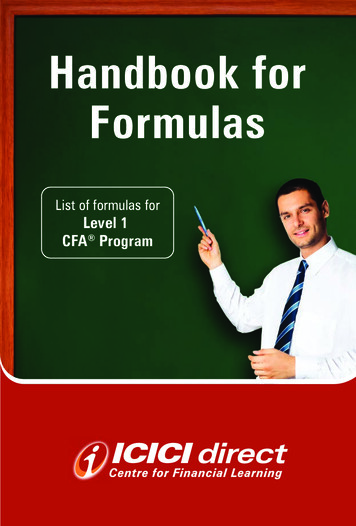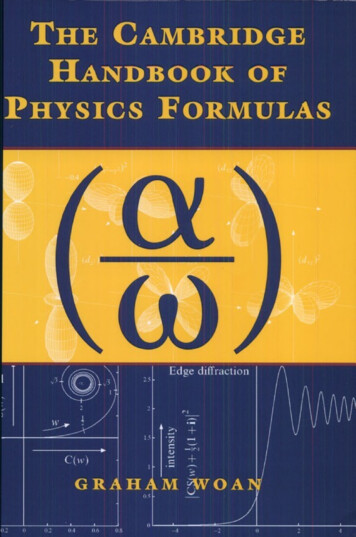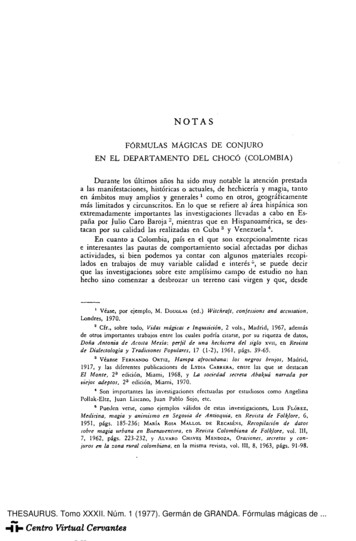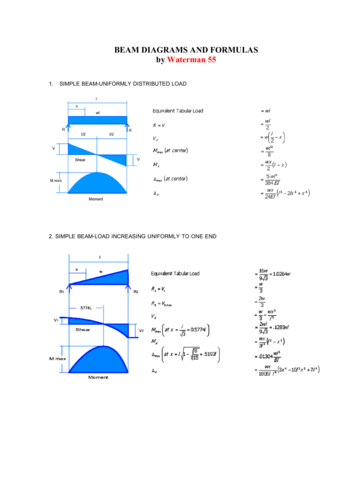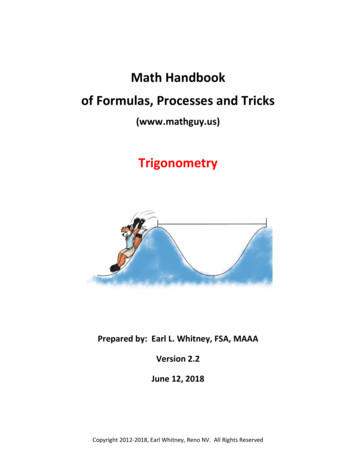
Transcription
Math Handbookof Formulas, Processes and Tricks(www.mathguy.us)TrigonometryPrepared by: Earl L. Whitney, FSA, MAAAVersion 2.2June 12, 2018Copyright 2012‐2018, Earl Whitney, Reno NV. All Rights Reserved
Note to StudentsThis Trigonometry Handbook was developed primarily through work with a number of HighSchool and College Trigonometry classes. In addition, a number of more advanced topics havebeen added to the handbook to whet the student’s appetite for higher level study.One of the main reasons why I wrote this handbook was to encourage the student to wonder;to ask “what about ” or “what if ”. I find that students are so busy today that they don’thave the time, or don’t take the time, to seek out the beauty and majesty that exists inMathematics. And, it is there, just below the surface. So be curious and go find it.The answers to most of the questions below are inside this handbook, but are seldom taught. Is there a method I can learn that will help me recall the key points on a unit circlewithout memorizing the unit circle?What’s the fastest way to graph a Trig function?Can I convert the sum of two trig functions to a product of trig functions? How aboutthe other way around, changing a product to a sum?Is there an easy way to calculate the area of a triangle if I am given its vertices as pointson a Cartesian plane?Don’t some of the Polar graphs in Chapter 9 look like they have been drawn with aSpirograph? Why is that?A cycloid is both a brachistochrone and a tautochrone. What are these and why arethey important? (you will have to look this one up, but it is well worth your time)What is a vector cross product and how is it used?How do the properties of vectors extend to 3 dimensions, where they really matter?Additionally, ask yourself: What trig identities can I create that I have not yet seen?What Polar graphs can I create by messing with trig functions? What makes a prettygraph instead of one that just looks messed up?Can I come up with a simpler method of doing things than I am being taught?What problems can I come up with to stump my friends?Those who approach math in this manner will be tomorrow’s leaders. Are you one of them?Please feel free to contact me at mathguy.us@gmail.com if you have any questions orcomments.Thank you and best wishes!EarlVersion 2.2Cover art by Rebecca Williams,Twitter handle: @jolteonkittyPage 2 of 109June 12, 2018
Trigonometry HandbookTable of ContentsPageDescription89999910111111121314Chapter 1: Functions and Special AnglesIntroductionAngle DefinitionsFunction Definitions on the x‐ and y‐ AxesPythagorean IdentitiesSine‐Cosine RelationshipKey Angles in Radians and DegreesCofunctionsUnit CircleFunction Definitions in a Right TriangleSOH‐CAH‐TOATrigonometric Functions of Special AnglesTrigonometric Function Values in Quadrants II, III, and IVProblems Involving Trig Function Values in Quadrants II, III, and IVProblems Involving Angles of Depression and Inclination15171920222426283032Chapter 2: Graphs of Trig FunctionsBasic Trig FunctionsCharacteristics of Trigonometric Function GraphsTable of Trigonometric Function CharacteristicsSine FunctionCosine FunctionTangent FunctionCotangent FunctionSecant FunctionCosecant FunctionApplication: Simple Harmonic Motion33333435Chapter 3: Inverse Trigonometric FunctionsDefinitionsPrincipal Values and RangesGraphs of Inverse Trig FunctionsProblems Involving Inverse Trigonometric Functions7Version 2.2Page 3 of 109June 12, 2018
Trigonometry HandbookTable of ContentsPageDescription373841414142Chapter 4: Key Angle FormulasAngle Addition, Double Angle, Half Angle FormulasExamplesPower Reducing FormulasProduct‐to‐Sum FormulasSum‐to‐Product FormulasExamples43444748Chapter 5: Trigonometric Identities and EquationsVerifying IdentitiesVerifying Identities ‐ TechniquesSolving Trigonmetic EquationsSolving Trigonmetic Equations ‐ Examples5152535456575960Chapter 6: Solving an Oblique TriangleSummary of MethodsLaws of Sines and CosinesLaws of Sines and Cosines ‐ ExamplesThe Ambiguous CaseFlowchart for the Ambiguous CaseAmbiguous Case ‐ ExamplesBearingsBearings ‐ Examples6161626263Chapter 7: Area of a TriangleGeometry FormulaHeron's FormulaTrigonometric FormulasCoordinate Geometry FormulaExamples646465656768Chapter 8: Polar CoordinatesIntroductionConversion between Rectangular and Polar CoordinatesExpressing Complex Numbers in Polar FormOperations on Complex Numbers in Polar FormDeMoivre's TheoremDeMoivre's Theorem for RootsVersion 2.2Page 4 of 109June 12, 2018
Trigonometry HandbookTable of ContentsPageDescription696970707174757677Chapter 9: Polar FunctionsParts of the Polar GraphSymmetryGraphing MethodsGraphing with the TI‐84 Plus CalculatorGraph Types (Circles, Roses, Limaçons, Lemniscates, Spirals)RoseCardioidConverting Between Polar and Rectangular Forms of EquationsParametric Equations79797980818384868686879092Chapter 10: VectorsIntroductionSpecial Unit VectorsVector ComponentsVector PropertiesVector Properties ‐ ExamplesDot ProductDot Product ‐ ExamplesVector ProjectionOrthogonal Components of a VectorWorkApplications of Vectors – ExamplesVector Cross ProductVector Triple Products93103105AppendicesAppendix A ‐ Summary of Trigonometric FormulasAppendix B ‐ Solving The Ambiguous Case ‐ Alternative MethodAppendix C ‐ Summary of Polar and Rectangular Forms106IndexVersion 2.2Page 5 of 109June 12, 2018
Trigonometry HandbookTable of ContentsUseful WebsitesMathguy.us – Developed specifically for math students from Middle School to College, basedon the author's extensive experience in professional mathematics in a business setting and inmath tutoring. Contains free downloadable handbooks, PC Apps, sample tests, and more.http://www.mathguy.us/Wolfram Math World – Perhaps the premier site for mathematics on the Web. This sitecontains definitions, explanations and examples for elementary and advanced math topics.http://mathworld.wolfram.com/Khan Academy – Supplies a free online collection of thousands of micro lectures via YouTubeon numerous topics. It's math and science libraries are extensive.www.khanacademy.orgAnalyze Math Trigonometry – Contains free Trigonometry tutorials and problems. Uses Javaapplets to explore important topics try.htmlSchaum’s OutlineAn important student resource for any high school or college math student is a Schaum’sOutline. Each book in this series provides explanations of the various topics in the course anda substantial number of problems for the student to try. Many of the problems are workedout in the book, so the student can see examples of how they should be solved.Schaum’s Outlines are available at Amazon.com, Barnes & Noble and other booksellers.Version 2.2Page 6 of 109June 12, 2018
Chapter 1Functions and Special AnglesIntroductionWhat is Trigonometry?The word “Trigonometry” comes from the Greek “trigonon” (meaning triangle)and “metron” (meaning measure). So, simply put, Trigonometry is the study ofthe measures of triangles. This includes the lengths of the sides, the measuresof the angles and the relationships between the sides and angles.The modern approach to Trigonometry also deals with how right triangles interact with circles,especially the Unit Circle, i.e., a circle of radius 1. Although the basic concepts are simple, theapplications of Trigonometry are far reaching, from cutting the required angles in kitchen tiles todetermining the optimal trajectory for a rocket to reach the outer planets.Radians and DegreesAngles in Trigonometry can be measured in either radians or degrees: There are 360 degrees i.e., 360 in one rotation around a circle. Although there are variousaccounts of how a circle came to have 360 degrees, most of these are based on the fact thatearly civilizations considered a complete year to have 360 days. There are 2 6.283 radians in one rotation around a circle. Theancient Greeks definedto be the ratio of the circumference of acircle to its diameter (i.e.,). Since the diameter is double theradius, the circumference is 2 times the radius (i.e.,2 ). Oneradian is the measure of the angle made from wrapping the radius of acircle along the circle’s exterior.r1 radrMeasure of an ArcOne of the simplest and most basic formulas in Trigonometry provides the measure of an arc in termsof the radius of the circle, , and the arc’s central angle θ, expressed in radians. The formula is easilyderived from the portion of the circumference subtended by θ.Since there are 2 radians in one full rotation around the circle, the measureof an arc with central angle θ, expressed in radians, is: Version 2.2θ22 θ2soPage 7 of 109June 12, 2018
Chapter 1Functions and Special AnglesAngle DefinitionsBasic DefinitionsA few definitions relating to angles are useful when beginning the study of Trigonometry.Angle: A measure of the space between rays with a common endpoint. An angle is typicallymeasured by the amount of rotation required to get from its initialside to its terminal side.Initial Side: The side of an angle from which its rotationalmeasure begins.Terminal Side: The side of an angle at which its rotationalmeasure ends.Vertex: The vertex of an angle is the common endpoint of the two rays that define the angle.Definitions in the Cartesian () PlaneWhen angles are graphed on a coordinatesystem (Rectangular or Polar), a number ofadditional terms are useful.Standard Position: An angle is in standardposition if its vertex is the origin (i.e., thepoint 0, 0 ) and its initial side is thepositive ‐axis.Polar Axis: The Polar Axis is the positive ‐axis. It is the initial side of all angles in standard position.Polar Angle: For an angle in standard position, its polar angle is the angle measured from the polaraxis to its terminal side. If measured in a counter‐clockwise direction, the polar angle is positive; ifmeasured in a clockwise direction, the polar angle is negative.Reference Angle: For an angle in standard position, its reference angle is the angle between 0 and90 measured from the ‐axis (positive or negative) to its terminal side. The reference angle can be0 ; it can be 90 ; it is never negative.Coterminal Angle: Two angles are coterminal if they are in standard position and have the sameterminal side. For example, angles of measure 50 and 410 are coterminal because 410 is one fullrotation around the circle (i.e., 360 ), plus 50 , so they have the same terminal side.Quadrantal Angle: An angle in standard position is a quadrantal angle if its terminal side lies oneither the ‐axis or the ‐axis.Version 2.2Page 8 of 109June 12, 2018
Chapter 1Functions and Special AnglesTrigonometric FunctionsTrigonometric Functions(on the ‐ and ‐axes)(for any angle θ)cossec1tancsc1cotsin θ1csc θcos θcos θ1sec θtan θtan θ1cot θtan θsin θcos θcot θcot θ1tan θcot θcos θsin θsec θsec θ1cos θcsc θcsc θ1sin θSine‐Cosine RelationshipPythagorean Identitiessinsin θsin θ1sin θ2cos θcos θKey Angles( 0 230 45 60 90 Cofunctions (in Quadrant I)sincostancotseccscVersion 2.2222 cossin cottan cscsec)0 radians6432radiansradiansradiansradians222Page 9 of 109June 12, 2018
Chapter 1Functions and Special AnglesThe Unit CircleThe Unit Circle diagram below provides ‐ and ‐values on a circle of radius 1 at key angles. At anypoint on the unit circle, the ‐coordinate is equal to the cosine of the angle and the ‐coordinate isequal to the sine of the angle. Using this diagram, it is easy to identify the sines and cosines of anglesthat recur frequently in the study of Trigonometry.Version 2.2Page 10 of 109June 12, 2018
Chapter 1Functions and Special AnglesTrigonometric Functions and Special AnglesTrigonometric Functions (Right nSpecial AnglesTrig Functions of Special Angles ( )RadiansDegrees00⁰ 30⁰ 45⁰ 60⁰ 90⁰ undefinedNote the patterns in the above table: In the sine column, the numbers 0 to 4 occur in sequenceunder the radical! The cosine column is the sine column reversed. Tangent sine cosine.Version 2.2Page 11 of 109June 12, 2018
Chapter 1Functions and Special AnglesTrigonometric Function Values in Quadrants II, III, and IVIn quadrants other than Quadrant I, trigonometric values for angles are calculated in the followingmanner: Draw the angle θ on the Cartesian Plane. Calculate the measure of the reference anglefrom the ‐axis to θ. Find the value of the trigonometric function ofthe angle in the previous step. Assign a “ ” or “ “ sign to the trigonometricvalue based on the function used and thequadrant θ is in (from the table at right).Examples:Θ in Quadrant II – Calculate: 180⁰120⁰, the reference angle is 180 Forsin 60 Θ in Quadrant III – Calculate:Forcos 30 , so: , so: 60 315 45 180 30 Θ in Quadrant IV – Calculate: 360⁰Fortan 45 Version 2.2120 180⁰210⁰, the reference angle is 210 315⁰, the reference angle is 360 1, so:Page 12 of 109 June 12, 2018
Chapter 1Functions and Special AnglesProblems Involving Trig Function Values in Quadrants II, III, and IVA typical problem in Trigonometry is to find the value of one or more Trig functions based on a set ofconstraints. Often, the constraints involve the value of another Trig function and the sign of yet athird Trig Function. The key to solving this type of problem is to draw the correct triangle in thecorrect quadrant.A couple of examples will illustrate this process.Example 1.1: sin, tanNotice that sinIn 3,0. Find the values of sec0 , tan0. Therefore,and cot .is in 3, so we draw the angle in that quadrant.is always positive. Since sinis negative;2,, we let3.Using the Pythagorean Theorem, we calculate the length of the horizontal3leg of the triangle:2 Then, sec And, cotExample 1.2: cotIn 2,is 5.negative, so we must haveNotice that cot 5. Since the angle is in 3,, cos0. Find the value of csc0 , cosis negative, and 0. Therefore,and cos .is in 2, so we draw the angle in that quadrant.is positive. Since cot, we let9,4.Using the Pythagorean Theorem, we can calculate the le
Outline. Each book in this series provides explanations of the various topics in the course and a substantial number of problems for the student to try. Many of the problems are worked out in the book, so the student can see examples of how they should be solved.
